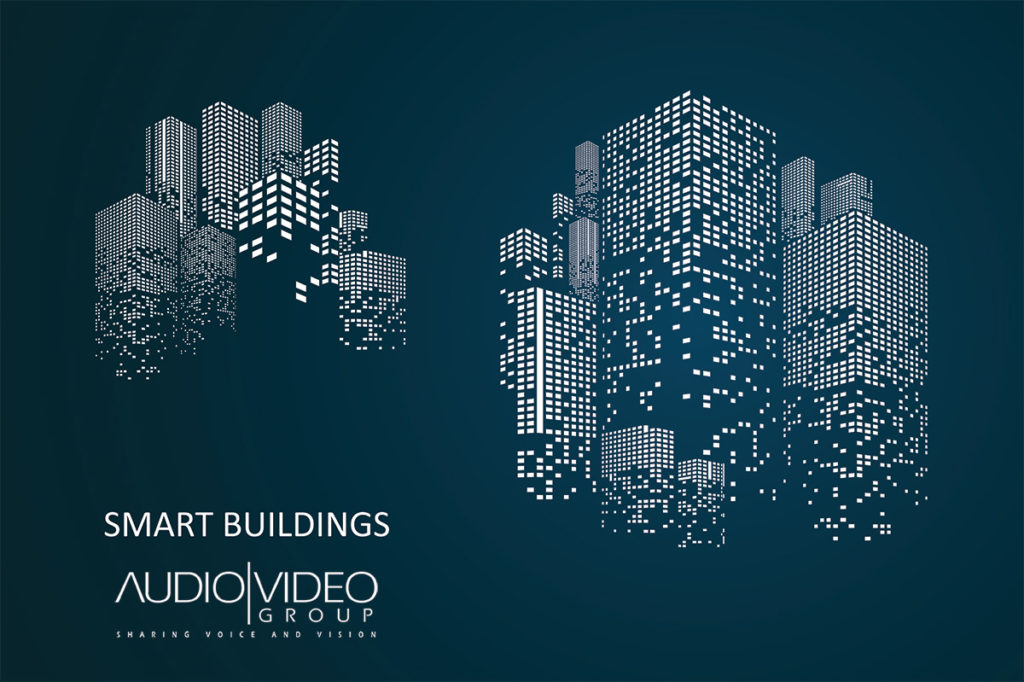Pros and Cons of Smart Buildings and Touchless Environments

The Pros and Cons of Smart Buildings and Touchless Environments
We live in the Smart Age. Everything around is turning smart – cellphones, cars, and even buildings. New tech opens countless possibilities for the inventive use of audio and video. This article will cover the latest AV trends in smart buildings and touchless environments.
What Is a Smart Building?
A smart building is a structure with built-in computerized maintenance and control features. They may include such systems as HVAC, lighting, access and security, sensors, alarms, and more.
Machine learning and artificial intelligence play an essential part in smart buildings, as they are used to analyze and predict usage patterns and manage resource allocation correspondingly. The use of cutting-edge engineering solutions makes maintaining the building much more efficient and cost-effective.
Versatility and Adaptability of Smart Buildings
Apart from these apparent benefits, smart buildings are extremely versatile and able to adapt to any conditions, which means they offer a productivity bump to businesses that operate in such buildings.
Also, smart technologies open a world of possibilities for creating touchless environments, which became a glaring trend following the COVID-19 outbreak. Imagine not having to touch anything – elevator buttons, access card readers, or light switches, and using your voice or gestures instead.
Not only does it feel cool, but it also drastically reduces the risks of germs spreading through surfaces that numerous people often touch.
How AV Technologies Are Used in Smart Buildings and Touchless Environments
As mentioned above, smart building tech can be used in many ways. Let’s start from the entrance. With a smart security system, you can get access to the building using a touchless biometric scan of your face.
The temperature and airflow in the lobby are automatically adjusted by AI, which reads the information from the cameras and makes decisions based on the number of people currently present on the premises.
You enter an elevator and get to your floor by simply speaking it out loud. When you exit the elevator, the lights in the hallway go on automatically. The door to your office room opens automatically because the security system knows you are nearby.
When you go into a meeting room to have a call, you don’t have to set it up: your calendar is synchronized with all the audio and video hardware in the room. It allows you to go online seamlessly, and your laptop is ready to present without any additional actions.
Sounds too good to be true? Well, maybe only some of the tech we mentioned above is widely available today, but we are definitely moving in this direction. And as this tech is implemented, you will notice more AV technology accompanying it…
- Interactive screens for communication, information, and navigation
- Audio interfaces at gates, elevators, front desks, and more
The Cons of Smart Buildings and Touchless Environments
Of course, no one and nothing is perfect in this world. There are some real potential downsides when speaking about smart buildings and touchless environments. The most obvious one is security.
Security Vulnerability of Smart Technology
When all the engineering and security equipment in a building is connected to one extensive network, the risk of unauthorized access is increasing. Depending on the nature of the breach and the perpetrators’ intention, the consequences may vary from relatively harmless pranks to full-fledged infrastructure and security system attacks.
With that in mind, smart buildings are equipped with top-notch data and access protection systems to minimize the risks. However, history teaches us that achieving 100% protection from such attacks is nearly impossible.
Energy Needs of Smart Technology
Another potential issue Is the energy dependence of all that high-tech hardware. In the case of a blackout, all systems not supported by some backup energy source become unusable.
Privacy Concerns
And last but not least, some people may be concerned about their privacy. Imagine an automatic system following your every step inside a building through security cameras, identifying you and memorizing your route – and storing all this data somewhere. Some may consider that it takes us a few steps closer to the dystopian future described in so many works of fiction.
The Future of Smart Buildings and Touchless Environments
Despite all the cons, smart buildings and touchless environments are not going away anytime soon. In fact, the future of this tech sector looks very bright, with exciting new tech becoming available every day.
Interactive Screens
Did you think interactive screens were the cutting edge? Say hello to touchless screens! With the help of AI and a set of sensors, such displays can predict where you want to touch the screen – and select the interactive element without your finger actually touching it.
Smart Voice and Audio Technology
Voice recognition tech is also on the rise. It is quite possible that in a couple of years, you will be able to use your voice for access authorization to get to your workplace, entering a business campus, or even ordering food at the drive-thru.
And here’s something most don’t know about. Smart tech in audio is so sophisticated now that it can reduce the noise of loud vehicles so the operator on the other end can hear you better. This is great news for gate operators who deal with a lot of diesel trucks!
No matter how advanced and futuristic you want your AV system to be – we are here to help! Call Audio-Video Group today, and let’s talk!

